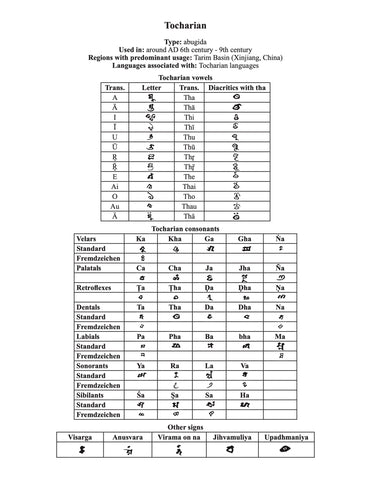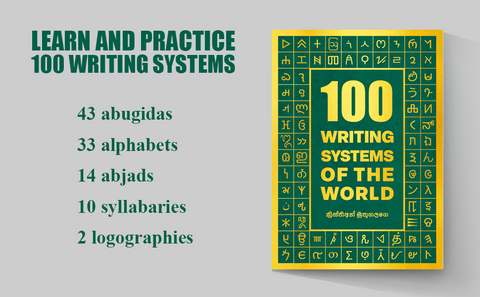Title: The Enigmatic Tocharian Script: A Window to the Ancient Silk Road

Introduction: The Tocharian script is a fascinating and mysterious writing system that offers a glimpse into the ancient cultures that once thrived along the Silk Road. This unique script has puzzled linguists and historians for centuries, as it was not deciphered until the 20th century.
1. Script type: The Tocharian script is an abugida, a type of writing system in which each character represents a consonant sound with an inherent vowel sound. Diacritical marks are used to modify the vowel sound.
2. Writing direction: The Tocharian script is written from left to right, similar to modern Western scripts.
3. Creator and invention time: The Tocharian script was created by the Tocharian people, an ancient group of Indo-European speakers who lived in the Tarim Basin, located in present-day Xinjiang, China. The script's invention time is believed to be around the 6th to 8th centuries CE.
4. Time period of use: The Tocharian script was primarily used from the 6th to the 8th centuries CE during the time of the Tocharian Kingdoms. These kingdoms were city-states that prospered along the Silk Road, engaging in trade and cultural exchanges with various neighboring civilizations.
5. Population and current usage: The Tocharian script was used by the Tocharian people, an ancient ethnic group that lived in the Tarim Basin. Today, the Tocharian people and their language no longer exist as a distinct group, and the script is not actively used in any contemporary society.
6. Usage area: The Tocharian script was used in the Tarim Basin, an important region along the Silk Road that connected East and West Asia. The Tarim Basin was a melting pot of cultures and languages, making it a significant area for trade and cultural exchange.
7. Languages associated: The Tocharian script was used to write the Tocharian languages, which were part of the Indo-European language family. There were two major Tocharian languages: Tocharian A and Tocharian B.
Interesting Facts and Historical Significance:
-
Rediscovery and Decipherment: The Tocharian script remained undeciphered until the early 20th century when scholars finally cracked its code. The decipherment of the script has been crucial in understanding the history and culture of the Tocharian people.
-
Linguistic Isolation: The Tocharian languages are some of the most ancient Indo-European languages, and they were geographically isolated in the Tarim Basin, which contributed to their unique linguistic features.
-
Silk Road Connection: The Tarim Basin was a vital part of the Silk Road, facilitating trade and cultural exchange between East and West Asia. The Tocharian script played a role in the transmission of knowledge and ideas along this ancient trade route.
-
Cultural Influences: The Tocharian culture was influenced by neighboring civilizations, including Indian, Iranian, and Central Asian cultures. This is evident in the script's close relationship with the Brahmi script used in South Asia.
Conclusion: The Tocharian script represents an intriguing chapter in the history of the ancient Silk Road and the cultures that thrived along its path. Through its decipherment, we have gained valuable insights into the linguistic diversity and cultural interactions of this enigmatic region. While the Tocharian script is no longer in use, its legacy endures in the records of the Tocharian Kingdoms and the history of the Tarim Basin, enriching our understanding of the ancient world and the intricate tapestry of human civilization.

Practice Tocharian and other scripts with our book "100 Writing Systems of the World"!
Discover 100 diverse writing systems from around the globe in one captivating book. Practice writing different scripts with full character charts and essential information provided. Let your imagination soar on the blank right pages as you explore 43 abugidas, 33 alphabets, 14 abjads, 10 syllabaries, and 2 logographic scripts. Dive into numeral systems and even design your own writing system. Immerse yourself in the beauty and diversity of global scripts today with "100 Writing Systems of the World." Unleash your creativity and order now!